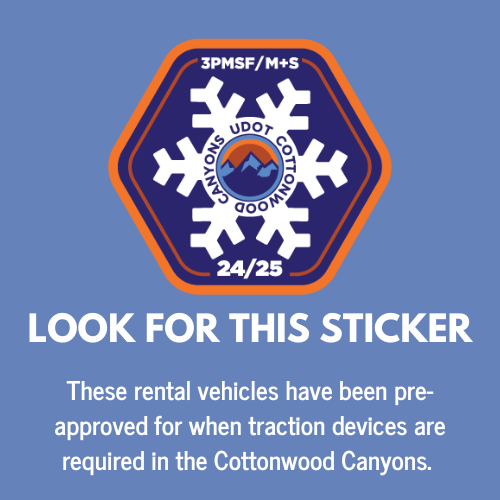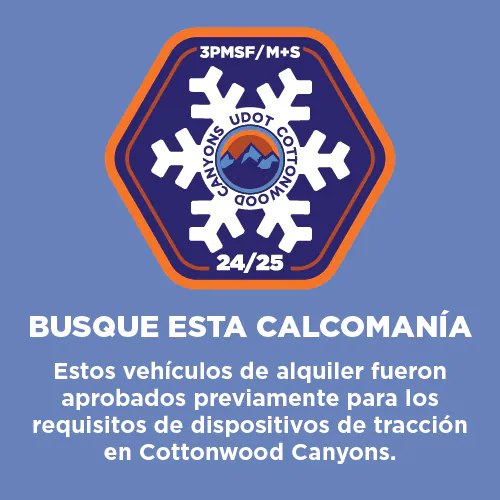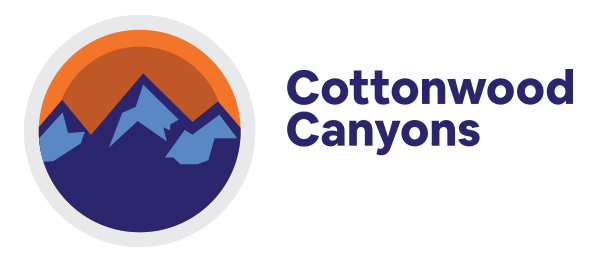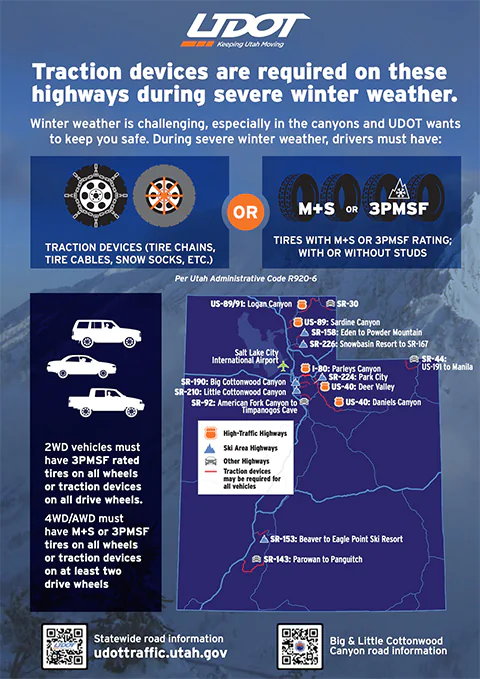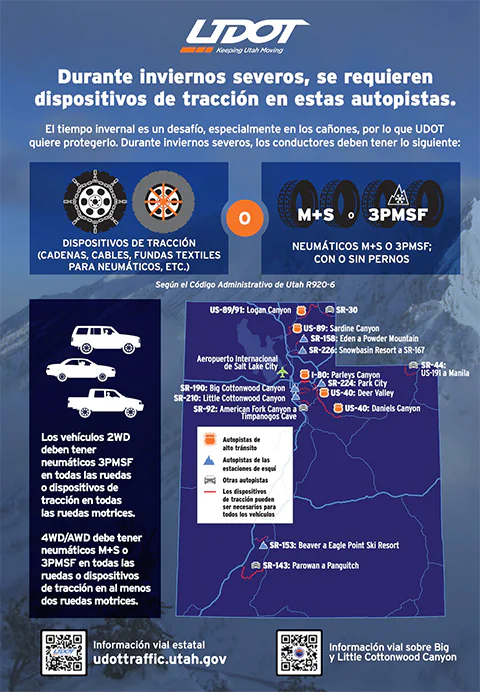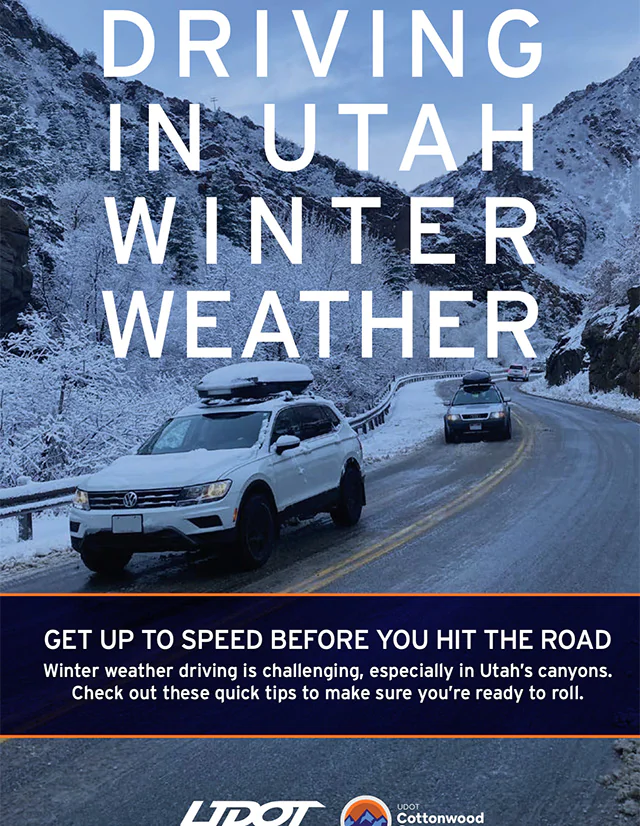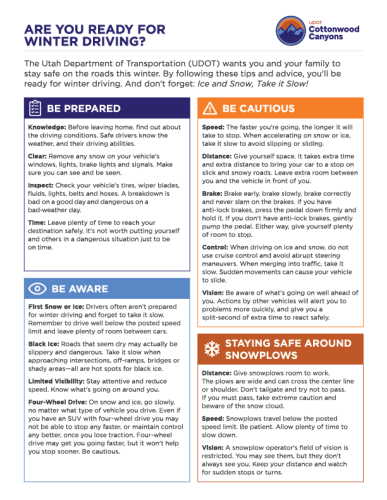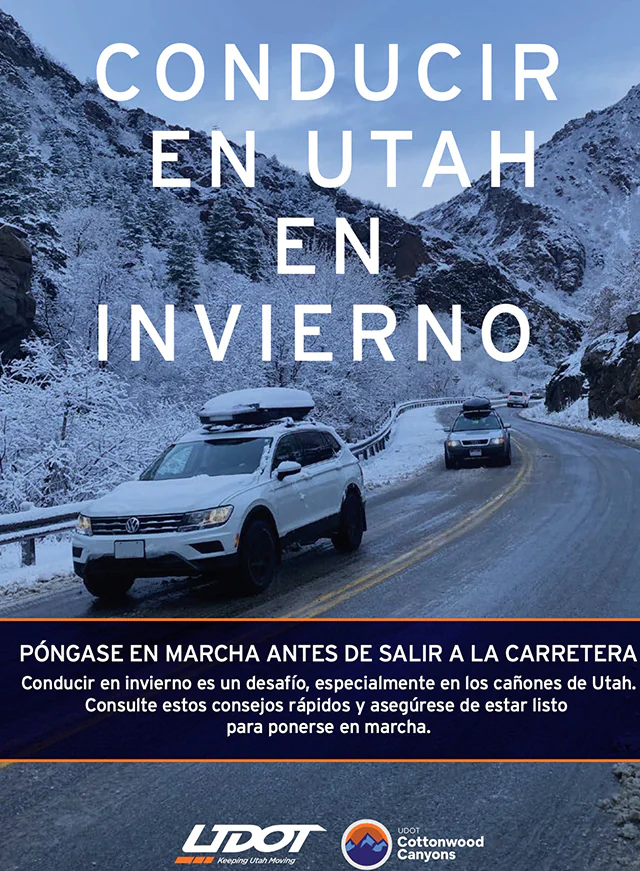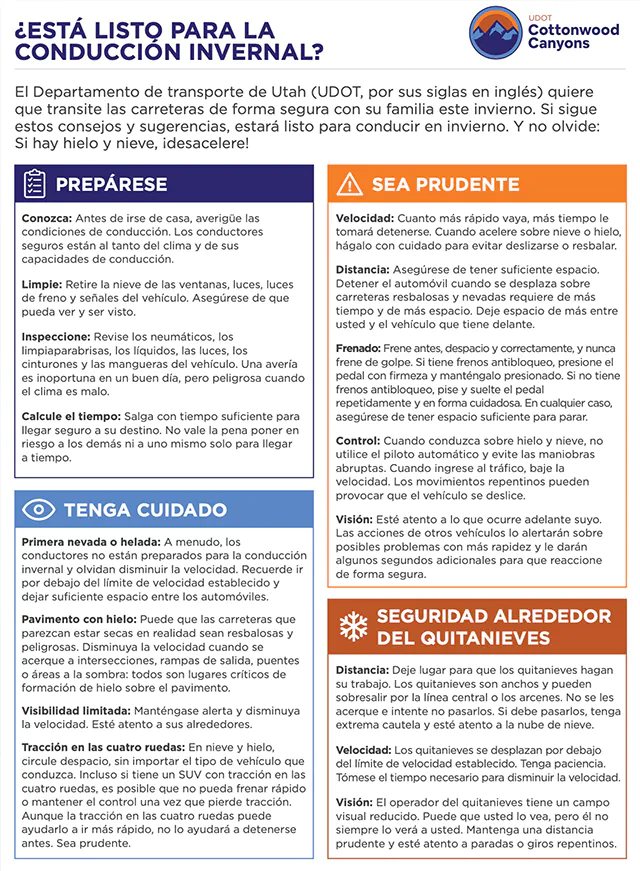UDOT TRACTION LAW //
What is the “Traction Law” and what are “Traction Devices”?
The Traction Law is Utah’s administrative rule (R20-6) that the Utah Department of Transportation (UDOT) and law enforcement implements during severe winter driving conditions. It is important to ensure that you have traction devices (snow tires, chains, snow socks, etc.) appropriate for winter driving conditions, it is the rule of the road. Traction devices are required during severe winter weather conditions on roads throughout Utah, including Big and Little Cottonwood Canyons.
AWD/4WD: M + S or M/S tires is the minimum requirement. Traction devices such as chains, snow socks, etc. or 3 peak mountain snowflake (3PMSF) tires are also acceptable and provide the most reliable traction in severe winter conditions.
2WD: 3 peak mountain snowflake (3PMSF) tires (on all four tires) is the minimum requirement. Traction devices such as chains, snow socks, etc. are also acceptable.
TRACTION LAW FREQUENTLY ASKED QUESTIONS
R920-6-4 (3)
When road surface conditions warrant, as determined by UDOT, UHP or designated local law enforcement agency, no vehicle will be allowed or permitted the use of the highway unless:
(a) For Class I Traction Segments, vehicles over 12,000 GVW shall be traction device equipped, and
(b) for Class II Traction Segments, all vehicles shall be traction device equipped or four-wheel drive as defined in this rule.
R920-6-4 (4)
Travelers are notified when traction devices are required via road signs and UDOT's traveler information systems.
R920-6-5. Responsibilities
(1) The decision to require traction devices is made by UDOT, UHP or a designated local law enforcement agency. The agency deciding to require traction devices notifies the other agencies involved.
(2) UHP and/or a designated local law enforcement agency enforces the traction device requirements.
(3) UDOT communicates traction device requirements to the public.
(4) Personnel authorized to enforce this rule may permit vehicles that do not meet traction device requirements to travel a traction segment of the highway if authorized personnel believe they may do so without endangering public safety, creating a hazard, or interfering with highway maintenance operations.
When chains are installed and driven on dry roads, it can damage both the vehicles and the road. Having chains on when the roads are dry also makes it difficult for drivers to steer and travel at posted speed limits.
Poor tire tread for snow, driver difficulty in navigating winter conditions and speed also contribute to slide offs/cashes.
It is critical that all travelers (even the locals) have confidence in their winter driving abilities. If you don’t, we recommend trying out the ski bus instead of white-knuckling it.
These tires perform better than all-season tires on snowy, slippery roads and low temperature or freezing roads. This is accomplished by a different rubber compound that provides more grip on snow and on cold pavement than an all-season tire.
The M+S rating means that a tire has better mud/snow traction than a summer tire, but the rating doesn’t reflect traction for wet, soupy mud, slush, ice, fresh snow or even cold, dry pavement.
Most all-season tires do not qualify for the 3PMSF symbol because the tread rubber in all-season and summer tires become hard at temperatures below 40 F.
Cottonwood Canyons Traction Law Enforcement Locations
2024/25 TRACTION LAW ENFORCEMENT
- The Utah Legislature provided funding to UDOT through HB 488 that can be used to increase Traction Law enforcement in the canyons.
- In response to public feedback on the sticker program, UDOT will use this funding to partner with local law enforcement agencies to increase Traction Law enforcement, and increase road safety in the canyons.
- The extra funding through this new partnership will help increase Traction Law enforcement without taking officers away from their other public safety responsibilities in the canyons.
- Cottonwood Heights Police Department will focus on the mouth of Big Cottonwood Canyon (SR-190) and Sandy City Police Department will focus on the mouth of Little Cottonwood Canyon (SR-210).
- Salt Lake County Sheriff’s Office will focus on assisting with the Snowbird Entry 1 merge point and providing assistance to vehicles in both canyons.
- We’re anticipating our partners will provide 1-2 officers per shift and up to 3-4 officers on busier days.
- Increased enforcement will start this season and focus on the morning uphill commute and the evening downhill commute as needed when there are storms that come in later in the day.
- Traction enforcement officers will be brought in when the traction lights are on during the winter season when resorts are open and the duration they are out there will vary with major storms, holidays, and when high volumes are expected.
- On avalanche closure days, officers will have the option to check tires while vehicles are staged to help traffic flow better when the road opens.
- All vehicles should have the proper traction devices installed before getting to the checkpoint to help keep traffic moving, people needing to install traction devices will need to exit the line and install them at designated chain up areas, refer to this map for locations.
- The Little Cottonwood Canyon enforcement/turnaround checkpoint is at A Gate/Gate Buttress (MP 5.2) The Big Cottonwood Canyon enforcement/turnaround checkpoint is at the chain up area (MP 2.2), just after the water plant and Canyon Estate Drive gates.
- Officers and their vehicles will be located at these locations so please drive alert for their safety and watch for their parked vehicles.
- We recommend that all travelers review this map, which shows enforcement/ turnaround checkpoints and chain up areas before heading to the canyons to be better prepared.
- Traffic delays are influenced by the number of vehicles in the canyons, road conditions like snow, ice or low visibility, poorly equipped vehicles, and driver skill. More enforcement will reduce the number of underprepared vehicles entering the canyons, but that is not the sole factor in traffic delays so some days you will still get stuck in traffic for extended periods of time.
- Enforcement in both canyons is moved farther away from the intersections at the mouth to minimize traffic backups into the community. More vehicles having stickers will speed up the inspection process.
- Better prepared vehicles and more informed drivers will help improve road safety for all canyons users.
- Have your traction devices on by the time you get to the checkpoint.
- Get a sticker so the officers only have to look for the sticker and not your tires since you have to have at least 5/32 tread depth to get a sticker.
- Carpool with someone who has a sticker or wait for the next available bus, especially if you’re not skilled or experienced in driving in the mountains during winter storms.
- Don’t drive distracted or too fast for conditions, the right traction devices can’t prevent crashes or slide offs if you’re doing either of those things.
- Be alert, watch for parked law enforcement vehicles and officers on the road, and give them a safe space to inspect tires.
- If you need to put on traction devices, please exit the line and install them at designated chain up areas, refer to this map for locations.
- Maintaining open and safe roads in the canyons is the highest priority for road operations and law enforcement; however, resources may not always be available for enforcement if they are needed for public safety or road operations support.
- All agencies need to respond to in-canyon incidents, have coverage areas beyond the canyons, and are actively assisting travelers throughout the day.
- Law enforcement agencies have to balance available resources with operational needs and cannot guarantee strict enforcement at all times as part of their regularly staffed duties. The extra funding through the partnership will help increase Traction Law enforcement without taking officers away from their other public safety responsibilities in the canyons and their surrounding coverage areas.
- Tracking how many vehicles are turned around at the checkpoints due to non-compliance with Traction Law requirements will help us gauge how many vehicles are properly equipped to travel in the canyons.
- Monitoring the total number of stickers handed out to drivers helps us assess the program reach and public participation over time, as well as the number of vehicles that have tire tread depth that exceeds minimum operating requirements to handle the challenging conditions in the canyons.
- We will conduct monthly surveys to gather feedback from the public about their experience with the enforcement program and how well it is working from their perspective.
- Continuing our annual surveys focused on the effectiveness and ease of the sticker program to help identify areas for improvement and measure overall program success from the users’ perspective.
WINTER DRIVING TIPS
WINTER DRIVING TIPS
RENTING A VEHICLE FOR WINTER WEATHER DRIVING
Winter weather driving is challenging, especially in the Cottonwood Canyons (SR-190, SR-210). If you are visiting from out-of-town and renting a vehicle, check with the rental company to verify that your vehicle is equipped with four-wheel drive (4WD) or all-wheel drive (AWD) and the correct tires.
UDOT has partnered with Enterprise Rent-A-Car, Alamo, National and Budget out of the Salt Lake City Airport as well as Rugged Rental and Go Rentals for the UDOT Cottonwood Canyons Sticker Program to pre-inspect rental vehicle tires for the 2024/25 season.
If you choose one of these companies to rent a vehicle during your visit to Utah, look for a vehicle with a sticker on the inside of the front windshield – this is a vehicle that has been pre-inspected and meets Utah’s traction law requirements.
Go-Rentals:
For reserving vehicles at the airport, contact Go-Rentals At Your Service at 1-800-464-8267 to get prequalified and you will be given steps on how and where to retrieve your rental vehicle at the SLC International Airport.
If you are arriving via private aircraft at any of the surrounding FBO’s, you can contact the Go-Rentals direct line at 801-893-9263, where they will enter the reservation in-house and meet your plane side upon arrival with your rental vehicle.
Budget:
If you reserve any class of SUV or pickup truck at a Budget of Utah location, customer service will help you identify a vehicle with the sticker at the time of rental.
Enterprise, Alamo, National:
Enterprise, Alamo and National provide the ability to reserve “Guaranteed AWD” car classes on their websites. If “Guaranteed AWD” vehicles are all reserved, this option will disappear from the available vehicle list. If it is not showing as available, then all cars with stickers are already reserved.
Rugged Rental:
All Rugged Rental SUV and truck-type vehicles are within the UDOT winter regulations. In addition, anything that has *4WD* or *AWD* on the Rugged Rental website also meets the requirements of the sticker program and Utah’s traction law.
